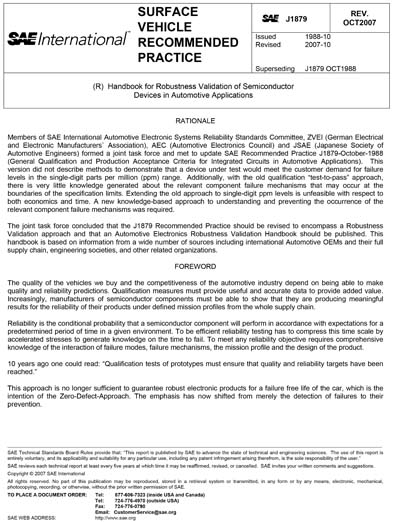Historical
SAE J 1879-2007 (SAE J1879-2007)
Handbook for Robustness Validation of Semiconductor Devices in Automotive Applications
This document will primarily address intrinsic reliability of electronic components for use in automotive electronics. Where practical, methods of extrinsic reliability detection and prevention will also be addressed. This document primarily deals with integrated circuit issues, but can easily be adapted for use in discrete or passive component qualification with the generation of a list of failure mechanisms relevant to those devices. Component qualification is the main scope of this document. Other procedures addressing extrinsic defects are specifically addressed in the monitoring chapter. This document is to be used within the context of achieving Zero Defect in component manufacturing and product use. This Robustness Validation Handbook provides the automotive electronics community with a common qualification methodology to demonstrate robustness levels necessary to achieve a desired reliability. The Robustness Validation approach requires testing the component to failure, or end-of-life (EOL), without introducing invalid failure mechanisms, and evaluation of the Robustness Margin between the outer limits of the customer specification and the actual performance of the component. The principles defined in this handbook are also applicable to automotive electronic modules and systems. Publications addressing these topics are currently under development by the SAE/ZVEI Joint Task Force. The Robustness Validation qualification practices defined in this document do not eliminate the need for qualification procedures found in JEDEC or AEC documents. Rather, these practices integrate robustness design methods (e.g., testto-failure in lieu of test-to-pass) into the automotive electronics design and development process. With successful implementation of robustness validation practices, the producer and consumer can realize the objectives of improved quality, cost, and time-to-market. The purpose of this Robustness Validation Handbook is to establish globally accepted Automotive concepts, processes, methods, techniques and tools for implementing the Robustness Validation qualification methodology for automotive semiconductor devices.
Content Provider
Society of Automotive Engineers [sae]






